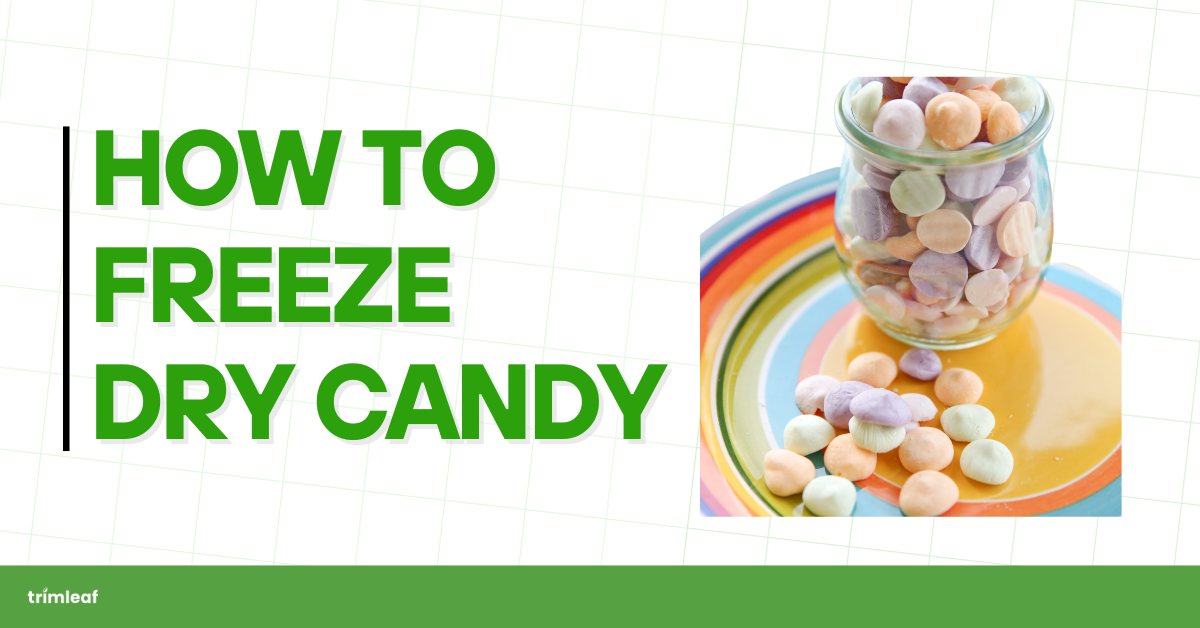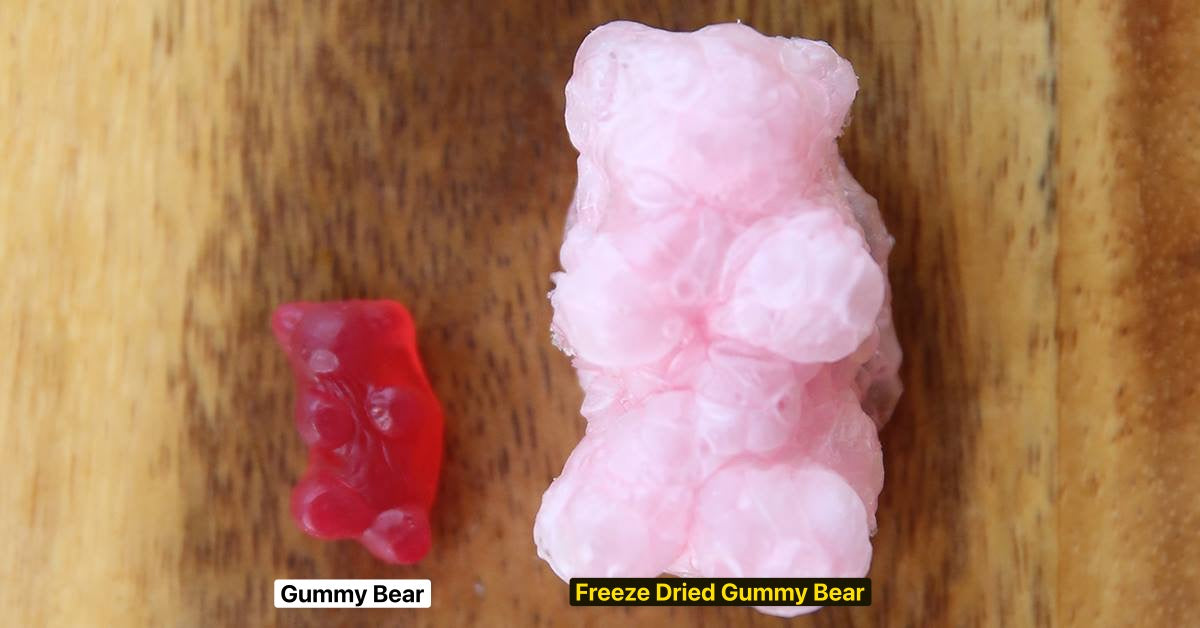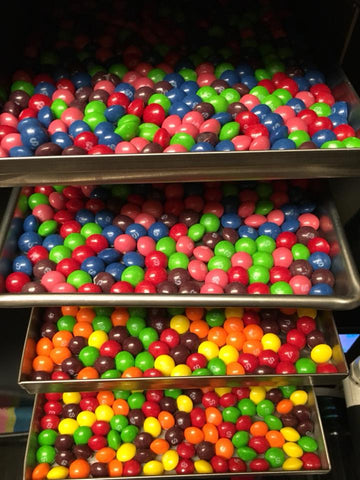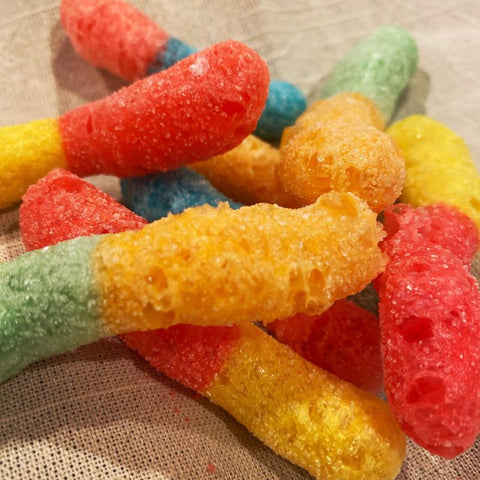
Imagine biting into a Skittle that melts in your mouth while exploding with intense, tangy flavor. Now, picture a gummy bear with a crispy shell, its chewy center bursting with sweetness. That's the magic of freeze-dried candy – a unique taste and texture experience that transforms ordinary treats into something extraordinary.
While freeze-drying is a powerful technique typically used for preserving food, when you apply this method to candy, it offers distinct benefits beyond simple preservation. Freeze-drying candy intensifies flavors, creates unique textures, and offers a completely new way to enjoy your favorite treats. In the example of freeze-drying a gummy bear, or freeze-drying Skittles, freeze-drying transforms the ordinary into the extraordinary, creating a playful and unexpected twist on your favorite sweets.
Ready to discover a whole new world of candy sensations?
What is Freeze Dried Candy?

Freeze-dried candy offers a taste and texture adventure unlike anything else! Imagine your favorite candies transformed – the flavors become more intense, the crunch takes on a whole new level, and some candies even become light and airy.
This process starts by rapidly freezing the candy and then typically placing it in a specialized machine called a freeze dryer. Inside the freeze dryer, a vacuum removes ice crystals directly as vapor. The result? A delicious snack that revolutionizes familiar treats, like sour Skittles, into an exciting and surprising puffy experience.
The Science Behind: What Does Freeze Drying Do to Candy?
Freeze-drying might sound like something out of a sci-fi movie, but it's a clever way to transform the texture and experience of candy. Here's a breakdown of how it works.
Step 1: The Deep Freeze
Candy is subjected to extremely low temperatures, which flash-freezes any water content into solid ice crystals.

Step 2: The Vacuum Stage
The frozen candy is placed in a vacuum chamber, where the air pressure is drastically reduced.

Step 3: Sublimation
With low pressure and sustained cold, ice crystals transform directly into vapor, leaving no liquid behind.

Step 4: The Final Product
The process leaves the candy with a new crispy texture, concentrated flavor, and an extended shelf life.

But Why Freeze-Dry Candy?
Freeze-dried candy offers several unique advantages. Its transformation into a crispy, melt-in-your-mouth texture makes it a fun snacking experience and perfect for decorating or gifting. Without the moisture that causes spoilage, freeze-dried candy has an extended shelf life, ideal for keeping snacks on hand or creating unique food presents. The lack of water also makes freeze-dried candy exceptionally lightweight and portable – perfect for hiking, camping, or just packing a satisfying treat in a lunchbox. Finally, its versatility extends to the kitchen; easily crush freeze-dried candy into a decorative powder for cakes, pastries, and other culinary creations.
Benefits of Freeze-Drying Candy
- Unique Textures: freeze-drying candy creates incredibly satisfying textures. Candies become airy, crispy, and melt-in-your-mouth in a completely new way.
- Intensified Flavors: freeze-dried candy flavors become more concentrated, resulting in a more intense taste experience with each bite.
- Extended Shelf Life: Freeze-drying dramatically reduces the chance of spoilage. Properly stored freeze-dried candies can last for months or even years.
- Lightweight and Portable: The lack of moisture makes freeze-dried candies incredibly lightweight, perfect for snacking on the go or taking on hikes and camping trips.
- It's Fun and Creative! Freeze-drying opens up a whole world of culinary experimentation, especially when you want to freeze dry candy at home. Use freeze-dried candies as toppings, mix them into recipes, or simply eat them as is to enjoy a familiar flavor in a new format.
The Best Kinds of Candy to Freeze Dry
It’s good to note that not all candies can be freeze-dried, but experimenting at home with a candy drying machine can yield surprising results. Those with high-fat content, such as chocolates, won’t freeze dry well. Now, some sweets freeze dry better because of their moisture levels. Thus, results will always vary from one candy to another. Here are some candies that freeze-dry well.
- Fruit-based candies, such as Skittles, which will create a crisp and more intense fruit flavor;
- Gummy worms and Gummy bears, when freeze-dried, create a crisp texture that elevates flavor profiles.
- Jelly beans are similar to gummy worms, as they produce a more concentrated flavor profile with a crispy texture when freeze-dried.
- Marshmallows also create a crisp texture but are suitable for use as decors for cakes and even gifts.
- Pop rocks are also suitable for freeze drying, as they have a more intense flavor while losing their stickiness.
- Hard candies, when freeze-dried, become crispy and also lose their stickiness. They’re also suitable for decorating cakes when crumbled.
- Chewy candies, such as taffy, tend to expand when freeze-dried, which becomes more crispy and flavorful.
- Cotton candy is also suitable for freeze drying, as it maintains the melt-in-your-mouth feel but in a crisp package.
Chocolate and chocolate-coated candies will have varying results. Due to the fat content in chocolates, they may or may not freeze dry properly. The texture might be crisp outside, but the inside will be different. Considering that not all candies freeze dry well, you should experiment with a small batch first to see if the results suit your liking.
Materials to Freeze Dry Candy
To freeze dry candies, you will need:
For the most part, you will have baking sheets or trays if you have a freeze dryer. You can get parchment paper and airtight containers from any baking supply shop, essentials for those without a machine but still want to freeze dry candy at home.
How to Freeze Dry Candy

Like other freeze-drying tutorials on this site, avoid overloading the trays with candy. You want a consistent result, so ensure your candies have enough space for the process. Note that some candies expand when freeze-dried, so it's important to allow for extra room.
Before freeze-drying, remove any wrappers from the candy and lay it on a baking sheet lined with parchment paper. Arrange the candies evenly, leaving space between them. As a rule, smaller candies freeze-dry better, so try breaking up larger candies to fit on the tray. Once arranged, freeze the candies until completely solid.
Once frozen, you can freeze-dry the candies. Place the trays into your freeze dryer and set the freezing temperature to zero and the drying temperature to 135 degrees Fahrenheit. If you're using a Harvest Right freeze dryer, use the dedicated "candy mode" setting.
The freeze-dried candy should be completely dry and not sticky. If any moisture remains, don't hesitate to run the candies through your freeze dryer for another cycle. Overdrying won't harm them, as your goal is to remove as much moisture as possible.
Once dry, let the candy rest at room temperature. Store them in an airtight container with desiccant packets to absorb moisture and prolong their shelf life. As with other freeze-dried food, keep your candies away from direct sunlight and humid environments.
General Tips:
- Before freeze-drying, please take out the candy from any wrapper it may have and lay it on a baking sheet lined with parchment paper.
- Smaller candies freeze-dry better. Break up any large pieces to ensure even freeze-drying.
- Place the candy on the freeze-dryer trays in a single layer. Don't overcrowd the trays, which will slow the drying process.
- Freeze your candy for at least 24 hours before starting the freeze-drying process. This will help ensure that the candy dries evenly and doesn't melt.
- Monitor the candy closely during the drying process. The drying time will vary depending on the candy type and the pieces' thickness.
- Once the candy is dry, it will be very fragile. Be careful when handling it.
Now, there are three freeze-drying techniques applied for candy: standard, warm trays, and hot start. Each method has its strengths, mainly when used with certain candies.
![Harvest Right [6-Tray] Large Pro Stainless Steel Freeze Dryer w/ Mylar Kit](https://cdn.shopify.com/s/files/1/1383/1731/files/harvest-right-harvest-right-stainless-steel-large-freeze-dryer-w-mylar-starter-kit-40756671578343_600x_4f279140-614d-48bf-b7f7-5eaab4c03396_480x480.webp?v=1712093519)
Standard Technique
- Prepare the candy: Spread the candy out in a single layer on the baking sheets or trays. This will ensure even freeze-drying.
- Load the freeze dryer: Carefully place the trays with candy into your freeze dryer.
- Set the freezing temperature: Adjust the freeze dryer's freezing temperature to 0 degrees Fahrenheit.
- Set the drying temperature: Set the drying temperature to 135 degrees Fahrenheit.
- Activate Candy Mode (if applicable): If you have a Harvest Right freeze dryer, activate the "Candy Mode." This will automatically adjust the settings for optimal candy freeze-drying. This will automatically adjust the settings for optimal candy freeze-drying, eliminating the need for a manual defrost cycle.
- Start the cycle: Begin the freeze-drying cycle. The length of the cycle will depend on the type of candy and the size of your freeze dryer.
- Check for doneness: Once the cycle is complete, check to see if the candy is completely dry. It should be light, airy, and easily breakable. If not, continue the drying process for a little longer.
- Remove and store: Remove the freeze-dried candy from the trays and store it in an airtight container in a cool, dry place.
Ideal for: Wide range of candies, especially those with distinct shapes or textures. Eg. Fruit-based candies (like Skittles), or gummy bears/worms, jelly beans.
Warm Trays
-
Preheat trays:
- With Candy Mode: If your freeze dryer has a "Candy Mode," activate it and it will include a tray warming cycle.
- Without Candy Mode: Preheat your oven to a temperature between 90°F - 120°F (32°C - 49°C). Place the empty trays in the oven for a few minutes until they are slightly warmed.
- Prepare the candy: While your trays are warming, spread your chosen candy in a single layer on the trays.
- Load the freeze dryer: Carefully place the trays of candy into your freeze dryer.
- Start freeze-drying: Begin the freeze-drying process as usual. The warm trays will help speed up the initial freeze-drying phase.
Important Notes:
- Don't overheat: It's crucial not to exceed 120°F (49°C) when warming your trays, as this could start to melt some candies.
- Candy types: The warm trays technique is particularly beneficial for candies that might stick together or lose their shape during the freeze-drying process.
Ideal for: Best for candies prone to sticking together or losing their shape during the process. Eg- soft, fluffy candies (like marshmallows), light and airy candies (like cotton candy).
Hot Start
-
Choose your heating method: Decide whether you'll use an oven or a microwave for the hot start.
- Oven: Provides more even heating.
- Microwave: Faster, but requires more careful monitoring to avoid melting.
-
Prepare the candy: Spread the candy out in a single layer on the baking sheets or trays.
-
Preheat your chosen appliance:
-
Oven: Preheat your oven to the appropriate temperature:
- Hard & chewy candies: 110°F - 140°F (43°C - 60°C)
- Taffy: 140°F - 160°F (60°C - 71°C)
- Microwave: Microwave will not have specific temperatures settings.
-
Oven: Preheat your oven to the appropriate temperature:
-
Heat the candy:
- Oven: Place the trays of candy in the preheated oven. Monitor closely and optionally use a thermometer to check for the internal temperature of a test candy.
- Microwave: Heat the candy in short bursts of 10-15 seconds, stirring between each burst. Check the candy frequently to avoid melting.
-
Achieve softening: You want the candy to be softened, but not fully melted. It should be slightly pliable.
-
Load the freeze dryer: Quickly transfer the softened candy trays into your freeze dryer.
-
Start freeze-drying: Begin the freeze-drying cycle as usual. The candy is already partially through the sublimation process, leading to a potentially faster drying time.
Important Notes:
- Candy Choice: The hot start method is best for hard candies, chewy candies, and taffy, which are prone to cracking or textural issues during freeze-drying.
- Temperature Control: The key is careful temperature control and observation to achieve softening without melting.
Ideal for: Works well for candies that benefit from slight softening to prevent cracking and maintain texture. Eg. - hard candies, chewy candies, taffy.
End Results

The freeze-dried candy should be dry and not sticky. If your candy still feels moist, don't hesitate to give it another run in your freeze dryer. You don't have to worry about overdrying it; you intend to remove as much moisture inside the candy.
You can let the candy rest at room temperature once the candy is dry. Store them in an airtight container and add desiccant packets to absorb moisture and prolong their shelf life. Like other freeze-dried food, keep sweets away from direct sunlight and humid environments.
Storing Freeze-Dried Candy

To store freeze-dried candies, you should place them in airtight container such as mason jars or mylar bags to maintain their freshness and prevent moisture from getting in. It is important to store freeze-dried candies in a cool, dry place away from direct sunlight.
Avoid storing them in areas with high humidity as this can cause the candies to become sticky and lose their crispness. Additionally, keep the candies away from strong odors as they can easily absorb unwanted flavors.
If stored properly, freeze-dried candies can last for several months to a year. However, it is best to consume them sooner rather than later to enjoy them at their peak freshness and flavor.
Can You Freeze Dry Candy Without a Freeze Dryer?
Yes, you can! While afreeze dryer provides the best results, you can still freeze dry candy at home and achieve similar effect using simple techniques. Let's explore two ways to enjoy freeze-dried fruit without a specialized machine:
Using a Household Freezer
- Choose candies with some moisture content, like gummies, chewy candies, or even chocolate with fillings. Cut them into bite-sized pieces.
- Arrange the candy pieces on a parchment-lined baking sheet, ensuring they don't touch.
- Freeze your candy for 1-3 weeks, depending on the thickness of the candy and the temperature of your freezer. Check periodically after the first week for dryness.
- Transfer the frozen candy to freezer bags and store them in a cool, dry place.
- Before eating, let the candy thaw for a few hours at room temperature. The moisture will separate, leaving a crunchy, chewy, and uniquely textured treat.
Using Dry Ice
- Choose your favorite candies and place them into freezer bags, leaving the bags slightly open.
- Place the bags in a cooler and cover the candy with dry ice. Leave the cooler slightly ajar to prevent dangerous pressure buildup.
- Allow the candy to freeze-dry for at least 24 hours in a dry environment.
- Carefully transfer the freeze-dried candy to new, clean bags and seal. Store them in a cool, dry place, ready for an unexpected taste experience.
Tips:
- Properly freeze-dried candy should retain most of its original color. If it looks discolored, it might need a bit more time in the dry ice.
- Freeze-dried candy can be a fun and surprising addition to your usual snacks!
Conclusion
Freeze-drying candy is a unique way to give life to treats with a twist. They work flawlessly even for older candies that are still fit for consumption but have remained untouched. By freeze-drying them, you give the typical sweet treats a new twist, unlocking more flavors. Whether you eat them as is or add them as an ingredient for another treat, your result is guaranteed to excite your sweet senses. Try experimenting with different candies and see the results you get. You’ll be surprised at what you discover when you freeze-dry these treats.
Ready to try freeze-drying candy yourself? With the right tools, the possibilities are even sweeter!
-
Explore our selection of high-quality freeze dryers for sale and choose the model that suits your needs: Freeze Dryers for Candy
-
Want to learn even more about using a freeze dryer for tasty treats? Our in-depth review covers it all: Our Review of the Harvest Right Freeze Dryer for those looking to freeze-dry candy at home.
Unlock the secret to amazing freeze-dried candy! Grab our exclusive cheat sheet with precise temperature and time guides for perfectly fluffy, flavorful results every time. Subscribe below!
Frequently Asked Questions
Yes, you can freeze dry candy at home without a machine using a method that involves using a cooler and dry ice.
You can freeze dry a variety of candies such as skittles, gummy worms, taffy, and other gummy candies.
Yes, you can purchase a freeze dryer to make your own freeze-dried candy at home. It is a good option for those who want to freeze dry foods regularly.
You can freeze dry candy without a machine by using a cooler, dry ice, and a vacuum pump to create the necessary conditions for freeze-drying.
The best way to freeze dry candy at home is by using a freeze-drying machine if you have one. If not, you can follow alternative methods using a cooler and dry ice.
To store freeze-dried candies, you should place them in airtight containers or bags to maintain their freshness and prevent moisture from getting in. It is important to store freeze-dried candies in a cool, dry place away from direct sunlight. Avoid storing them in areas with high humidity as this can cause the candies to become sticky and lose their crispness. Additionally, keep the candies away from strong odors as they can easily absorb unwanted flavors. If stored properly, freeze-dried candies can last for several months to a year. However, it is best to consume them sooner rather than later to enjoy them at their peak freshness and flavor.
Freeze drying is known to preserve the nutritional value of foods, so you can freeze dry candy without significantly affecting its nutritional content.
The freeze drying process for candies involves freezing them first, then placing them in a freeze dryer to remove moisture through sublimation, resulting in light and crispy freeze-dried treats.




